engine INFINITI QX56 2011 Factory Owner's Manual
[x] Cancel search | Manufacturer: INFINITI, Model Year: 2011, Model line: QX56, Model: INFINITI QX56 2011Pages: 5598, PDF Size: 94.53 MB
Page 442 of 5598

BCS-54
< ECU DIAGNOSIS INFORMATION >
BCM
*: For Canada
Fail-safeINFOID:0000000006274820
FAIL-SAFE CONTROL BY DTC
BCM performs fail-safe control when any DTC are detected.
102
(BR) Ground P/N position Input Selector lever P or N position 12 V
Except P and N positions 0 V
104
(R/B) Ground A/T shift selector
(detention switch)
power supply Output Ignition switch ON 12 V
105
(O/L) Ground Stop lamp switch 2 Input Ignition switch OFF Battery voltage
106
(Y/G) Ground
Blower fan motor re-
lay control Output Ignition switch OFF or ACC 0 V
ON 12 V
107 (L) Ground
Steering lock condi-
tion No. 1 Input Steering lock LOCK status 0 V
UNLOCK status 12 V
108 (P) Ground
Steering lock condi-
tion No. 2 Input Steering lock LOCK status 12 V
UNLOCK status 0 V
109
(L/W) Ground ACC indicator lamp Output Ignition switch OFF (LOCK indicator is
not illuminated)
Battery voltage
ACC 0 V
Te r m i n a l N o .
(Wire color) Description
Condition Va l u e
(Approx.)
Signal name Input/
Output
+ −
Display contents of CONSULT Fail-safe Cancellation
B2013: ID DISCORD BCM-S/ L Inhibit engine cranking When communication between BCM and steering lock unit are commu-
nicated normally.
B2014: CHAIN OF S/L-BCM Inhibit engine cranking When communication between BCM and steering lock unit are commu-
nicated normally.
B2192: ID DISCORD BCM-ECM Inhibit engine cranking Erase DTC
B2193: CHAIN OF BCM-ECM Inhibit engine cranking Erase DTC
B2195: ANTI-SCANNING Inhibit engine cranking Ignition switch ON → OFF
B2198: NATS ANTENNA AMP Inhibit engine cranking Erase DTC
B2557: VEHICLE SPEED In hibit steering lockWhen the following CAN signal status (vehicle speed signal) becomes
consistent
Vehicle speed signal (ABS)
Vehicle speed signal (Meter)
B2601: SHIFT POSITION Inhibit steering lock 500 ms after the following signal reception status becomes consistent
Selector lever P position switch signal
P range signal (CAN)
B2602: SHIFT POSITION Inhibit steering lock 5 seconds after the following BCM recognition conditions are fulfilled
Ignition switch is in the ON position
Selector lever P position switch signal: Except P position (battery volt-
age)
Vehicle speed: 4 km/h (2.5 MPH) or more
Revision: 2010 May2011 QX56
Page 443 of 5598

BCS
BCM
BCS-55
< ECU DIAGNOSIS INFORMATION >
C
D E
F
G H
I
J
K L
B A
O P
N
B2603: SHIFT POSI STATUS Inhibit steering lock
500 ms after any of the following BCM recognition conditions are fulfilled
Status 1
- Ignition switch is in the ON position
- Selector lever P position switch signal: Except P position (12 V)
- Selector lever P/N position signal: Except P and N positions (0 V)
Status 2
- Ignition switch is in the ON position
- Selector lever P position switch signal: P position (0 V)
- Selector lever P/N position signal: P or N positions (12 V)
B2604: PNP/CLUTCH SW Inhibit steering lock 500 ms after any of the following BCM recognition conditions are fulfilled
Status 1
- Ignition switch is in the ON position
- Selector lever P/N position signal: P or N position (12 V)
- Shift position signal (CAN): P or N position
Status 2
- Ignition switch is in the ON position
- Selector lever P/N position signal: Except P and N positions (0 V)
- Shift position signal (CAN): Except P and N position
B2605: PNP/CLUTCH SW Inhibit steering lock 500 ms after any of the following BCM recognition conditions are fulfilled
Status 1
- Power position: IGN
- Selector lever P/N position signal: Except P and N positions (0 V)
- Interlock/PNP switch signal (CAN): OFF
Status 2
- Ignition switch is in the ON position
- Selector lever P/N position signal: P or N position (12 V)
- Interlock/PNP switch signal (CAN): ON
B2608: STARTER RELAY Inhibit engine cranking 500 ms after the following signal communication status becomes con-
sistent
Starter motor re
lay control signal
Starter relay status signal (CAN)
B2609: S/L STATUS Inhibit engine crank-
ing
Inhibit steering lock When the following steering lock conditions agree
BCM steering lock control status
Steering lock condition No. 1 signal status
Steering lock condition No. 2 signal status
B260B: STEERING LOCK UNIT Inhibit steering lock Erase DTC
B260D: STEERING LOCK UNIT Inhibit steering lock Erase DTC
B260F: ENG STATE SIG LOST Inhibit engine cranking When any of the following conditions are fulfilled
Power position changes to ACC
Receives engine status signal (CAN)
B2612: S/L STATUS Inhibit engine crank-
ing
Inhibit steering lock When any of the following conditions are fulfilled
Steering lock unit status signal (CAN) is received normally
The BCM steering lock control status matches the steering lock status
recognized by the steering lock unit status signal (CAN from IPDM E/
R)
B2619: BCM Inhibit engine cranking 1 second after the steering lock unit power supply output control inside
BCM becomes normal
B26EF: STRG LCK RELAY OFF Inhibit engine cranking When the following conditions are fulfilled
Steering lock relay signal (CAN): ON
Steering lock unit status signal (CAN): ON
B26F0: STRG LCK RELAY ON Inhibit engine cranking When the following conditions are fulfilled
Steering lock relay signal (CAN): OFF
Steering lock unit status signal (CAN): OFF
B26F1: IGN RELAY OFF Inhibit engine cranking When the following conditions are fulfilled
Ignition switch ON signal (CAN: Transmitted from BCM): ON
Ignition switch ON signal (CAN: Transmitted from IPDM E/R): ON
B26F2: IGN RELAY ON Inhibit engine cranking When the following conditions are fulfilled
Ignition switch ON signal (CAN: Transmitted from BCM): OFF
Ignition switch ON signal (CAN: Transmitted from IPDM E/R): OFF
Display contents of CONSULT Fail-safe Cancellation
Revision: 2010 May2011 QX56
Page 444 of 5598

BCS-56
< ECU DIAGNOSIS INFORMATION >
BCM
FAIL-SAFE CONTROL BY RAIN SENSOR MALFUNCTION
BCM detects the light and rain sensor serial link error and the rain sensor malfunction.
BCM controls the following fail-safe when rain sensor has a malfunction.
Front wiper switch AUTO and sensing rain drop: The condition just before the activation of fail-safe is main-
tained until the front wiper switch is turned OFF.
Front wiper switch AUTO and not sensing rain drop: Front wiper is LO operation until the front wiper switch is
turned off.
REAR WIPER MOTOR PROTECTION
BCM detects the rear wiper stopping position acco rding to the rear wiper stop position signal.
When the rear wiper stop position signal does not c hange for more than 5 seconds while driving the rear
wiper, BCM stops power supply to protect the rear wiper motor.
Condition of cancellation
1. More than 1 minute is passed after the rear wiper stop.
2. Turn rear wiper switch OFF.
3. Operate the rear wiper swit ch or rear washer switch.
FAIL-SAFE CONTROL OF COMBINATION SWITCH READING FUNCTION CAUSED BY LOW
POWER SUPPLY VOLTAGE
If voltage of battery power supply lower, BCM maintain s combination switch reading to the status when input
voltage is less than approximately 9 V.
NOTE:
When voltage of battery power supply is approximately 9 V or more, combination switch reading function
returns to normal operation.
DTC Inspection Priority ChartINFOID:0000000006274821
If some DTCs are displayed at the same time, perfo rm inspections one by one based on the following priority
chart.
B26F3: START CONT RLY ON Inhibit engine cranking When the following conditions are fulfilled
Starter control relay signal (CAN: Transmitted from BCM): OFF
Starter control relay signal (CAN: Transmitted from IPDM E/R): OFF
B26F4: START CONT RLY OFF Inhibit engine cranking When the following conditions are fulfilled
Starter control relay signal (CAN: Transmitted from BCM): ON
Starter control relay signal (CAN: Transmitted from IPDM E/R): ON
B26F7: BCM Inhibit engine cranking
by Intelligent Key sys-
temWhen room antenna and luggage room antenna functions normally
U0415: VEHICLE SPEED Inhibit steering lock When vehicle speed signal (Meter) (CAN) is received normally
Display contents of CONSULT Fail-safe Cancellation
Priority DTC
1 B2562: LOW VOLTAGE
2 U1000: CAN COMM
U1010: CONTROL UNIT (CAN)
3 B2192: ID DISCORD BCM-ECM
B2193: CHAIN OF BCM-ECM
B2195: ANTI-SCANNING
B2198: NATS ANTENNA AMP
Revision: 2010 May2011 QX56
Page 473 of 5598

PRECAUTIONSBR-3
< PRECAUTION >
C
DE
G H
I
J
K L
M A
B
BR
N
O P
PRECAUTION
PRECAUTIONS
Precaution for Supplemental Restraint System (SRS) "AIR BAG" and "SEAT BELT
PRE-TENSIONER"
INFOID:0000000006228171
The Supplemental Restraint System such as “A IR BAG” and “SEAT BELT PRE-TENSIONER”, used along
with a front seat belt, helps to reduce the risk or severi ty of injury to the driver and front passenger for certain
types of collision. This system includes seat belt switch inputs and dual stage front air bag modules. The SRS
system uses the seat belt switches to determine the front air bag deployment, and may only deploy one front
air bag, depending on the severity of a collision and whether the front occupants are belted or unbelted.
Information necessary to service the system safely is included in the “SRS AIR BAG” and “SEAT BELT” of this
Service Manual.
WARNING:
• To avoid rendering the SRS inoper ative, which could increase the risk of personal injury or death in
the event of a collision that would result in air ba g inflation, all maintenance must be performed by
an authorized NISSAN/INFINITI dealer.
Improper maintenance, including in correct removal and installation of the SRS, can lead to personal
injury caused by unintentional act ivation of the system. For removal of Spiral Cable and Air Bag
Module, see the “SRS AIR BAG”.
Do not use electrical test equipm ent on any circuit related to the SRS unless instructed to in this
Service Manual. SRS wiring harnesses can be identi fied by yellow and/or orange harnesses or har-
ness connectors.
PRECAUTIONS WHEN USING POWER TOOLS (AIR OR ELECTRIC) AND HAMMERS
WARNING:
When working near the Air Bag Diagnosis Sensor Unit or other Air Bag System sensors with the
ignition ON or engine running, DO NOT use air or electric power tools or strike near the sensor(s)
with a hammer. Heavy vibration could activate the sensor(s) and deploy the air bag(s), possibly
causing serious injury.
When using air or electric power tools or hammers , always switch the ignition OFF, disconnect the
battery, and wait at least 3 minutes before performing any service.
Precaution Necessary for Steering Wh eel Rotation after Battery Disconnect
INFOID:0000000006228172
NOTE:
Before removing and installing any control units, first tu rn the push-button ignition switch to the LOCK posi-
tion, then disconnect both battery cables.
After finishing work, confirm that all control unit connectors are connected properly, then re-connect both
battery cables.
Always use CONSULT-III to perform self-diagnosis as a part of each function inspection after finishing work.
If a DTC is detected, perform trouble diagnos is according to self-diagnosis results.
For vehicle with steering lock unit, if the battery is disconnected or discharged, the steering wheel will lock and
cannot be turned.
If turning the steering wheel is required with the batte ry disconnected or discharged, follow the operation pro-
cedure below before starting the repair operation.
OPERATION PROCEDURE
1. Connect both battery cables. NOTE:
Supply power using jumper cables if battery is discharged.
2. Turn the push-button ignition switch to ACC position. (At this time, the steering lock will be released.)
3. Disconnect both battery cables. The steering lock wil l remain released with both battery cables discon-
nected and the steering wheel can be turned.
4. Perform the necessary repair operation.
Revision: 2010 May2011 QX56
Page 477 of 5598
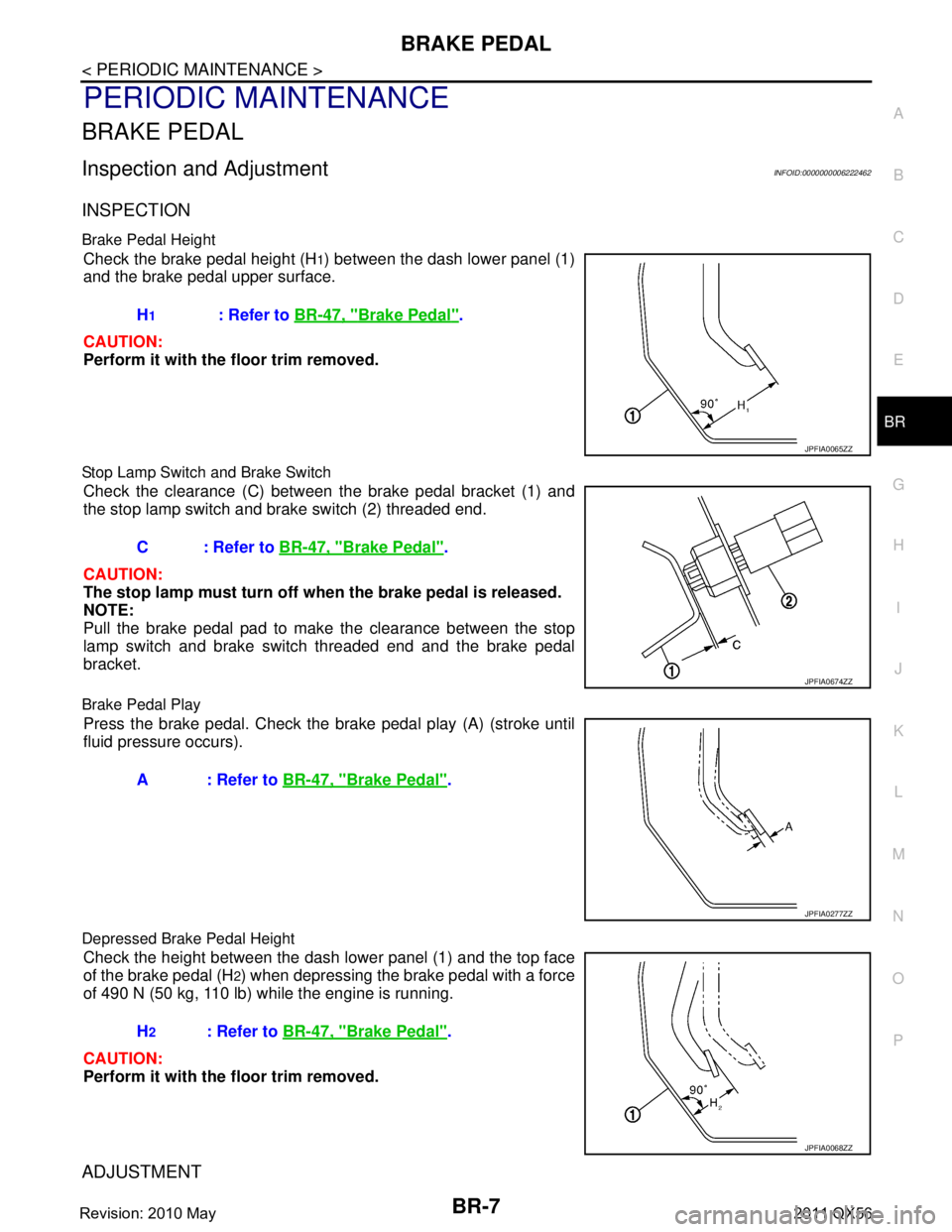
BRAKE PEDALBR-7
< PERIODIC MAINTENANCE >
C
DE
G H
I
J
K L
M A
B
BR
N
O P
PERIODIC MAINTENANCE
BRAKE PEDAL
Inspection and AdjustmentINFOID:0000000006222462
INSPECTION
Brake Pedal Height
Check the brake pedal height (H1) between the dash lower panel (1)
and the brake pedal upper surface.
CAUTION:
Perform it with the floor trim removed.
Stop Lamp Switch and Brake Switch
Check the clearance (C) between the brake pedal bracket (1) and
the stop lamp switch and brake switch (2) threaded end.
CAUTION:
The stop lamp must turn off when the brake pedal is released.
NOTE:
Pull the brake pedal pad to make the clearance between the stop
lamp switch and brake switch threaded end and the brake pedal
bracket.
Brake Pedal Play
Press the brake pedal. Check the brake pedal play (A) (stroke until
fluid pressure occurs).
Depressed Brake Pedal Height
Check the height between the dash lower panel (1) and the top face
of the brake pedal (H
2) when depressing the brake pedal with a force
of 490 N (50 kg, 110 lb) while the engine is running.
CAUTION:
Perform it with the floor trim removed.
ADJUSTMENT
H1: Refer to BR-47, "Brake Pedal".
JPFIA0065ZZ
C : Refer to BR-47, "Brake Pedal".
JPFIA0674ZZ
A : Refer to BR-47, "Brake Pedal".
JPFIA0277ZZ
H2: Refer to BR-47, "Brake Pedal".
JPFIA0068ZZ
Revision: 2010 May2011 QX56
Page 479 of 5598
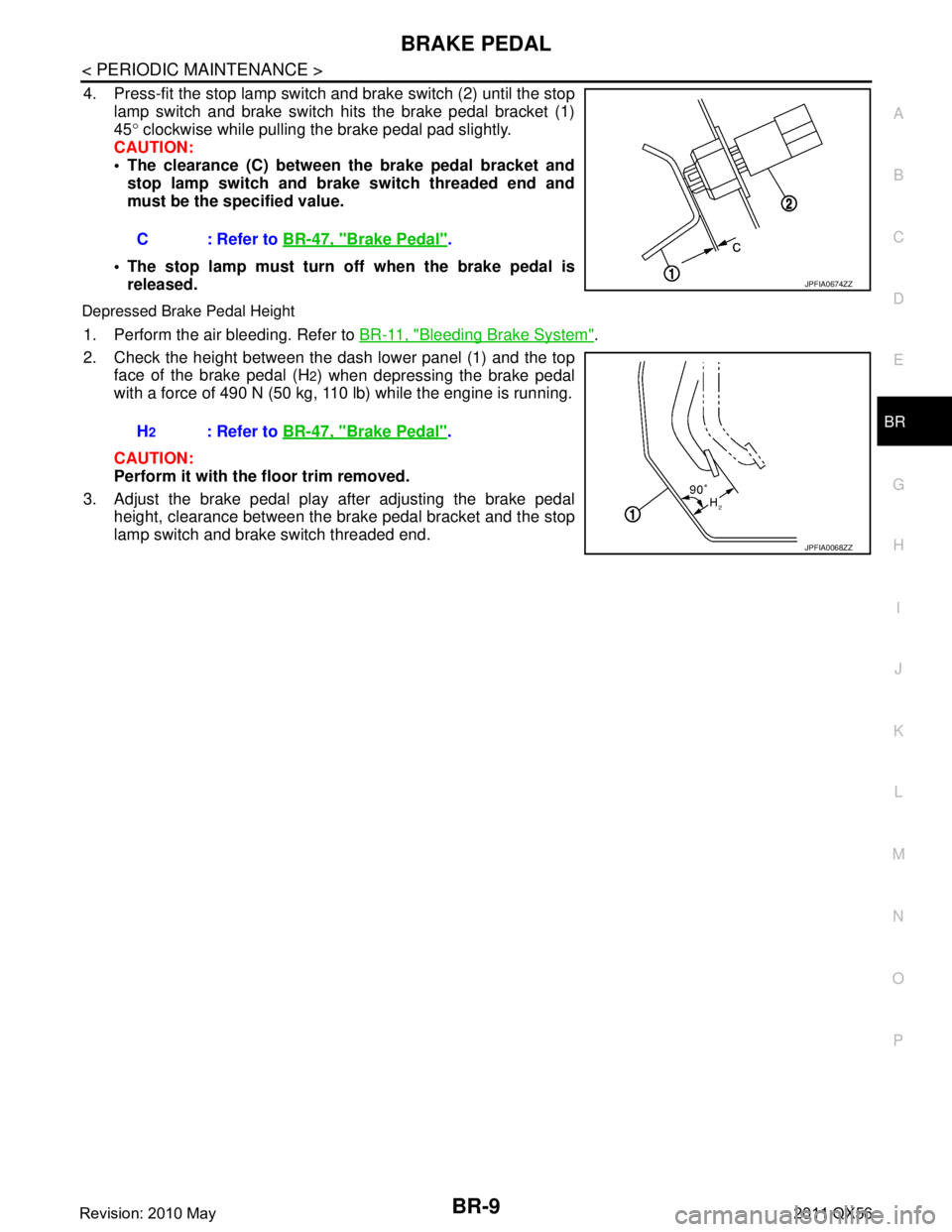
BRAKE PEDALBR-9
< PERIODIC MAINTENANCE >
C
DE
G H
I
J
K L
M A
B
BR
N
O P
4. Press-fit the stop lamp switch and brake switch (2) until the stop
lamp switch and brake switch hits the brake pedal bracket (1)
45 ° clockwise while pulling the brake pedal pad slightly.
CAUTION:
The clearance (C) between the brake pedal bracket and stop lamp switch and brake switch threaded end and
must be the specified value.
The stop lamp must turn off when the brake pedal is released.
Depressed Brake Pedal Height
1. Perform the air bleeding. Refer to BR-11, "Bleeding Brake System".
2. Check the height between the dash lower panel (1) and the top face of the brake pedal (H
2) when depressing the brake pedal
with a force of 490 N (50 kg, 110 lb) while the engine is running.
CAUTION:
Perform it with the floor trim removed.
3. Adjust the brake pedal play after adjusting the brake pedal height, clearance between the brake pedal bracket and the stop
lamp switch and brake switch threaded end.C : Refer to
BR-47, "
Brake Pedal".
JPFIA0674ZZ
H2: Refer to BR-47, "Brake Pedal".
JPFIA0068ZZ
Revision: 2010 May2011 QX56
Page 480 of 5598
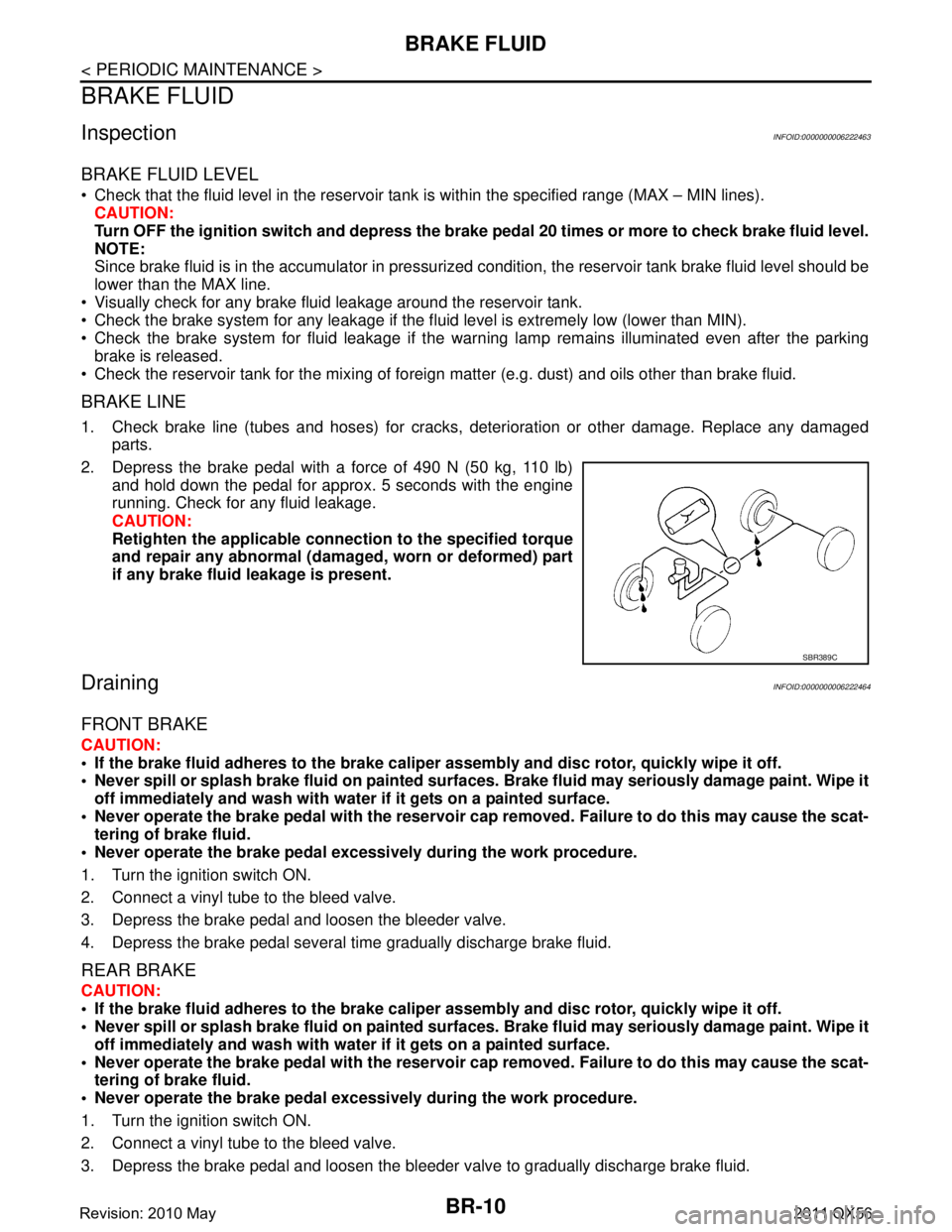
BR-10
< PERIODIC MAINTENANCE >
BRAKE FLUID
BRAKE FLUID
InspectionINFOID:0000000006222463
BRAKE FLUID LEVEL
Check that the fluid level in the reservoir tank is within the specified range (MAX – MIN lines).
CAUTION:
Turn OFF the ignition switch an d depress the brake pedal 20 times or more to check brake fluid level.
NOTE:
Since brake fluid is in the accumulator in pressurized condition, the reservoir tank brake fluid level should be
lower than the MAX line.
Visually check for any brake fluid leakage around the reservoir tank.
Check the brake system for any leakage if the fl uid level is extremely low (lower than MIN).
Check the brake system for fluid leakage if the warn ing lamp remains illuminated even after the parking
brake is released.
Check the reservoir tank for the mixing of foreign matter (e.g. dust) and oils other than brake fluid.
BRAKE LINE
1. Check brake line (tubes and hoses) for cracks, deterioration or other damage. Replace any damaged
parts.
2. Depress the brake pedal with a force of 490 N (50 kg, 110 lb) and hold down the pedal for approx. 5 seconds with the engine
running. Check for any fluid leakage.
CAUTION:
Retighten the applicable conn ection to the specified torque
and repair any abnormal (damag ed, worn or deformed) part
if any brake fluid leakage is present.
DrainingINFOID:0000000006222464
FRONT BRAKE
CAUTION:
If the brake fluid adheres to the brake caliper assembly and disc rotor, quickly wipe it off.
Never spill or splash brake fluid on painted surfaces. Brake fluid may seriously damage paint. Wipe it
off immediately and wash with wate r if it gets on a painted surface.
Never operate the brake pedal with the reservoir cap removed. Failure to do this may cause the scat-
tering of brake fluid.
Never operate the brake pedal excessively during the work procedure.
1. Turn the ignition switch ON.
2. Connect a vinyl tube to the bleed valve.
3. Depress the brake pedal and loosen the bleeder valve.
4. Depress the brake pedal several time gradually discharge brake fluid.
REAR BRAKE
CAUTION:
If the brake fluid adheres to the brake caliper assembly and disc rotor, quickly wipe it off.
Never spill or splash brake fluid on painted surfaces. Brake fluid may seriously damage paint. Wipe it
off immediately and wash with wate r if it gets on a painted surface.
Never operate the brake pedal with the reservoir cap removed. Failure to do this may cause the scat- tering of brake fluid.
Never operate the brake pedal excessively during the work procedure.
1. Turn the ignition switch ON.
2. Connect a vinyl tube to the bleed valve.
3. Depress the brake pedal and loosen the bleeder valve to gradually discharge brake fluid.
SBR389C
Revision: 2010 May2011 QX56
Page 485 of 5598
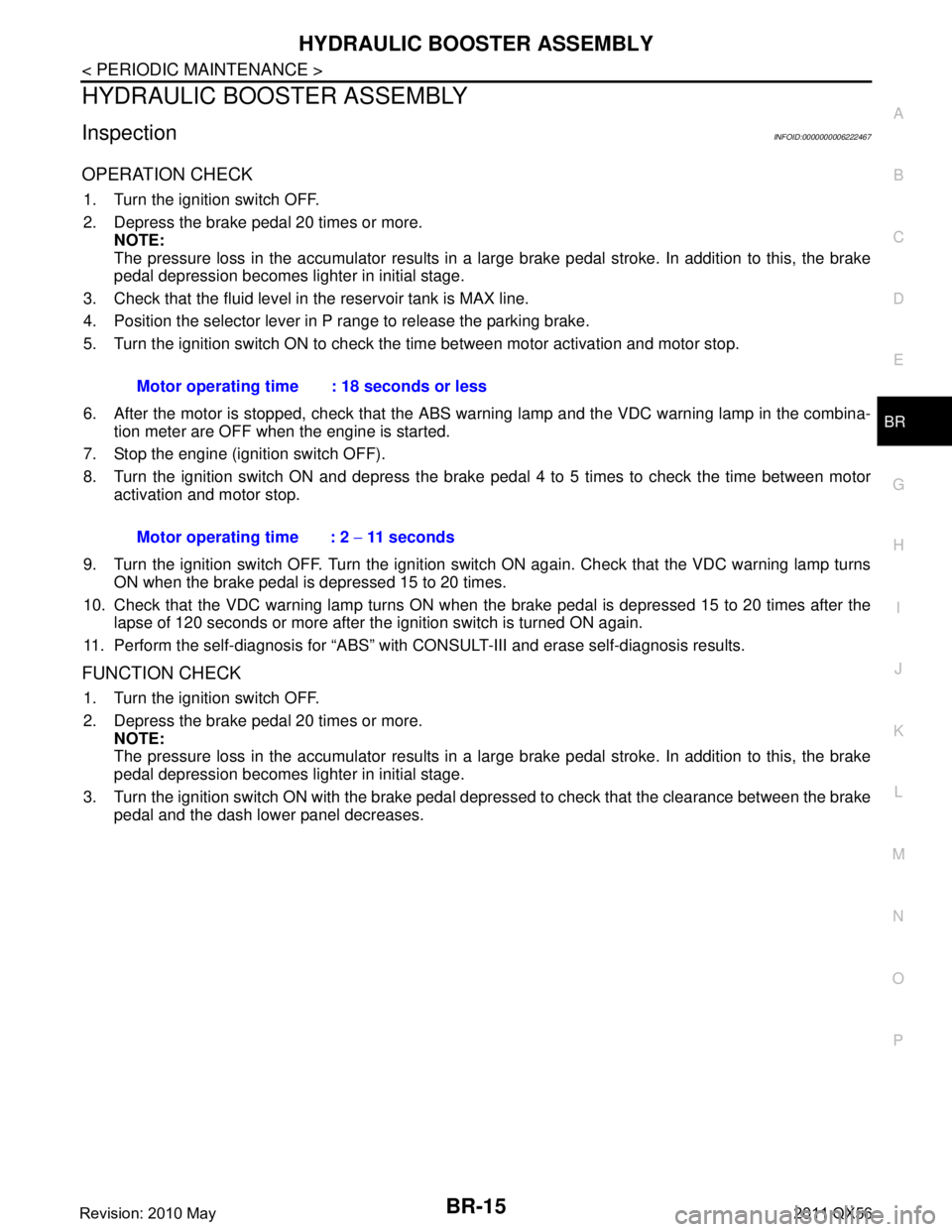
HYDRAULIC BOOSTER ASSEMBLYBR-15
< PERIODIC MAINTENANCE >
C
DE
G H
I
J
K L
M A
B
BR
N
O P
HYDRAULIC BOOSTER ASSEMBLY
InspectionINFOID:0000000006222467
OPERATION CHECK
1. Turn the ignition switch OFF.
2. Depress the brake pedal 20 times or more. NOTE:
The pressure loss in the accumulator results in a large brake pedal stroke. In addition to this, the brake
pedal depression becomes lighter in initial stage.
3. Check that the fluid level in the reservoir tank is MAX line.
4. Position the selector lever in P range to release the parking brake.
5. Turn the ignition switch ON to check the time between motor activation and motor stop.
6. After the motor is stopped, check that the ABS warning lamp and the VDC warning lamp in the combina- tion meter are OFF when the engine is started.
7. Stop the engine (ignition switch OFF).
8. Turn the ignition switch ON and depress the brake pedal 4 to 5 times to check the time between motor activation and motor stop.
9. Turn the ignition switch OFF. Turn the ignition switch ON again. Check that the VDC warning lamp turns ON when the brake pedal is depressed 15 to 20 times.
10. Check that the VDC warning lamp turns ON when the brake pedal is depressed 15 to 20 times after the lapse of 120 seconds or more after the ignition switch is turned ON again.
11. Perform the self-diagnosis for “ABS” with CONSULT-III and erase self-diagnosis results.
FUNCTION CHECK
1. Turn the ignition switch OFF.
2. Depress the brake pedal 20 times or more.
NOTE:
The pressure loss in the accumulator results in a large brake pedal stroke. In addition to this, the brake
pedal depression becomes lighter in initial stage.
3. Turn the ignition switch ON with the brake pedal depr essed to check that the clearance between the brake
pedal and the dash lower panel decreases. Motor operating time : 18 seconds or less
Motor operating time : 2
− 11 seconds
Revision: 2010 May2011 QX56
Page 494 of 5598
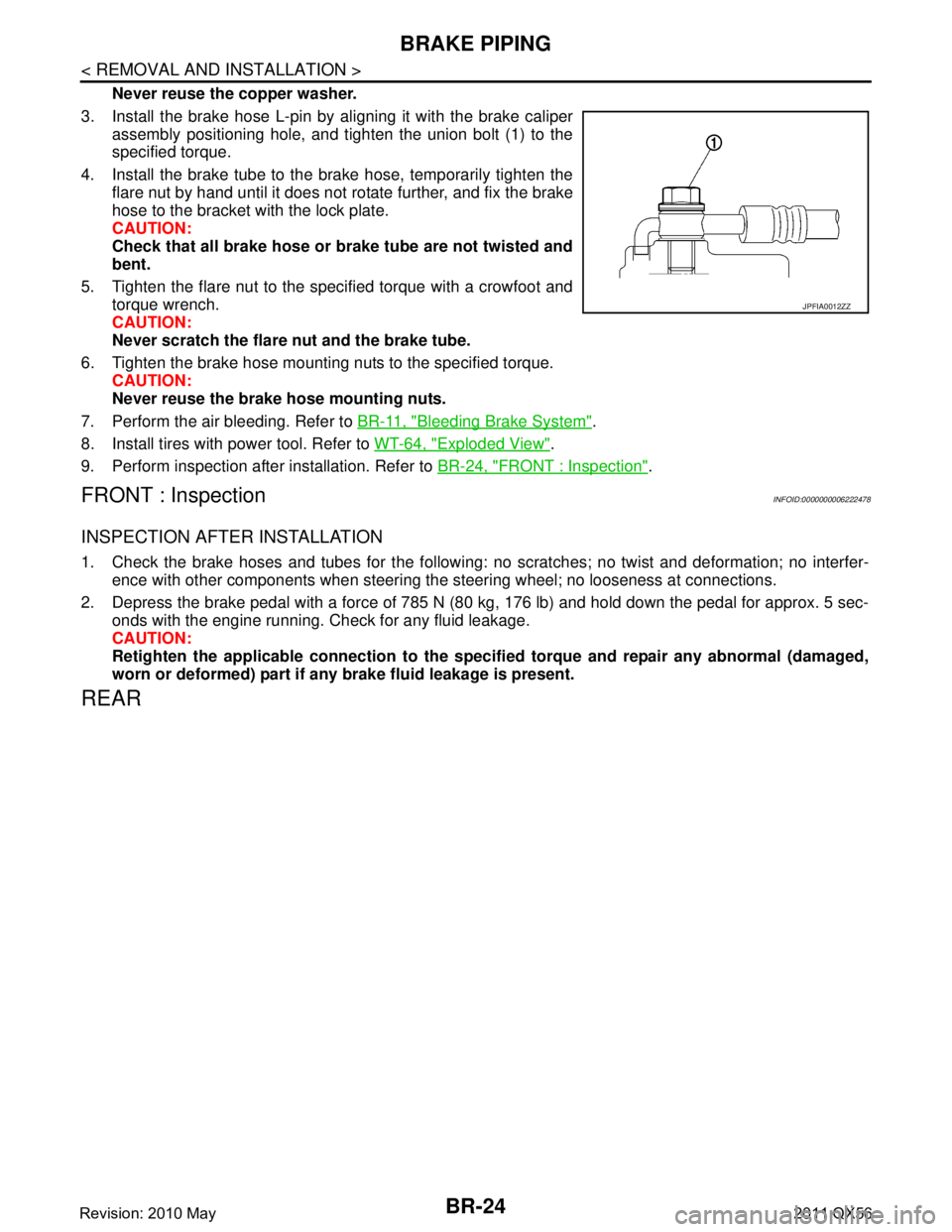
BR-24
< REMOVAL AND INSTALLATION >
BRAKE PIPING
Never reuse the copper washer.
3. Install the brake hose L-pin by aligning it with the brake caliper assembly positioning hole, and tighten the union bolt (1) to the
specified torque.
4. Install the brake tube to the brake hose, temporarily tighten the flare nut by hand until it does not rotate further, and fix the brake
hose to the bracket with the lock plate.
CAUTION:
Check that all brake hose or brake tube are not twisted and
bent.
5. Tighten the flare nut to the specified torque with a crowfoot and torque wrench.
CAUTION:
Never scratch the flare nut and the brake tube.
6. Tighten the brake hose mounting nuts to the specified torque. CAUTION:
Never reuse the brake hose mounting nuts.
7. Perform the air bleeding. Refer to BR-11, "
Bleeding Brake System".
8. Install tires with power tool. Refer to WT-64, "
Exploded View".
9. Perform inspection after installation. Refer to BR-24, "
FRONT : Inspection".
FRONT : InspectionINFOID:0000000006222478
INSPECTION AFTER INSTALLATION
1. Check the brake hoses and tubes for the following: no scratches; no twist and deformation; no interfer-
ence with other components when steering the steering wheel; no looseness at connections.
2. Depress the brake pedal with a force of 785 N (80 kg, 176 lb) and hold down the pedal for approx. 5 sec- onds with the engine running. Check for any fluid leakage.
CAUTION:
Retighten the applicable connection to the specified torque and repair any abnormal (damaged,
worn or deformed) part if any brake fluid leakage is present.
REAR
JPFIA0012ZZ
Revision: 2010 May2011 QX56
Page 497 of 5598

BRAKE PIPINGBR-27
< REMOVAL AND INSTALLATION >
C
DE
G H
I
J
K L
M A
B
BR
N
O P
2. Depress the brake pedal with a force of 785 N (80 kg, 176 lb) and hold down the pedal for approx. 5 sec- onds with the engine running. Check for any fluid leakage.
CAUTION:
Retighten the applicable connect ion to the specified torque and repair any abnormal (damaged,
worn or deformed) part if any brake fluid leakage is present.
Revision: 2010 May2011 QX56